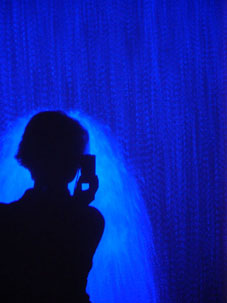 |
Ji-Hoon Byun’s Duk-eum |
The potency of the concept is felt as soon as you turn the corner and encounter Ji-Hoon Byun’s Duk-eum (South Korea). On a blank wall a soft textured blue—not quite so vibrant as Klein’s—is filled with falling particles of light. There is a tendency to speed past, afraid of casting a shadow on the artwork. However this is the point. Your movement through the light between projector and screen triggers the falling particles so that they cascade out and around your shadow like a waterfall of crystal light. The response of the particles is so well tuned that you experience a kind of physical displacement or ghosting—almost expecting to feel the weight of the particles on your skin.
The next work is just as playful. Tan Teck Weng’s Panopticon (Australia) consists of a screen showing an empty room with tables and chairs scattered around. If you pick up the small box at the base of the screen the furniture flies around the room as if possessed by a poltergeist. The initial impact of the work comes from trying to establish if it’s a virtual manifestation or real—is this the best 3D rendering ever seen? Having experienced the work several times now (it appears in Experimenta’s House of Tomorrow ) and knowing how it functions (let us say a surveillance camera is involved), the initial magic of the microcosm has diminished for me though the technical appreciation remains. However, the title Panopticon seems incongruous. The work originally involved the viewer’s peering eye projected onto a screen. With only half the work presented, the ramifications of surveillance are minimised and, with the box-interface set below the screen in the dark, many people (including large groups of game and interactive-literate school children when I was in the room) missed the experience of manipulating the furniture, merely glancing at a static image.
Looming over Panopticon is the large-scale projection of Tim Plaisted’s Surface Browser (Australia)—an alternative visual interface for surfing the net. Plaisted and collaborators Ryan Hodge and Anko have created an application that draws in the images from selected websites and re-presents them in a 3 dimensional format instead of the established horizontal/vertical screen. Drawing from the water imagery so frequently associated with the web (‘surfing’, ‘streaming’, ‘data pipes’), the interface features a soft blue pipeline that the viewer travels, with images wrapped around the curves and bends. For sci-fi readers there is a quiver of excitement as the work approaches visual manifestations of the cyber landscapes proposed in William Gibson’s novels. In his artist talk, Plaisted spoke of the different ways in which the work can be presented in the gallery context, including a joystick-driven version and a live-online juke-box system in which people enter websites that are queued for use as future content. Unfortunately Surface Browser is presented in MAAP as an archived, passive screen work so that its value remains conceptual. And in the absence of any accompanying text it is easy to view the work simply as a piece of video animation. You can, however, download a version of the surface browser (thoughtfully designed for cross platform usage) from www.boxc.net in order to experience the full potential of the work.
Offering a fully active interface, Shu Lea Cheang’s Burn is a website interface and installation looking at issues of filesharing and digital music reproduction. Comprising part of her ever expanding Kingdom of Piracy project (http://kop.fact.co.uk/), a curated portal for works dealing with ideas of piracy in all forms across Asia, Burn was inspired by widely broadcast images of pyres of pirated CDs. Offered as a celebration of the freedom offered by internet technologies, the interface allows people to browse through thousands of tracks that are untitled and only categorised by colour, and then to burn their own CDs. The content comes from everywhere, though many sound artists have uploaded their tracks. In a tall tower in the middle of the room are blank CDs with the word “Burn” stamped on them, and the Chinese character for “pirate.” The software application is simple, offering little more than standard audio/CD burning software besides an appealingly colourful and intuitive graphic interface. It is in the flagrant subversiveness of the concept that the work’s strength lies. Depending on legal advice, often the work cannot be presented fully utilising the CD burning capacities of the software. The arts organisation in Taiwan originally involved in commissioning the Kingdom of Piracy project has since withdrawn its support.
Kim Machan’s curatorial emphasis is on re-affirming new media art within the visual art context and history, deftly conveyed in her calling forth the spirit of Yves Klein. This approach has created an exhibition with a cohesive thematic force. However, by actively resisting the pull of cutting edge technologies the exhibition presents a very modest selection of interactive and hybrid installations. Interestingly, 2 South Korean works—Ji-Hoon Byun’s Duk-eum and Kim Kichul’s Sound Drawing (see “An Eye for Sound”, p26) offer the most satisfying experiences. Refreshingly, the discussion generated by Machan’s curation focuses on concepts, with technology playing a supporting role. However there is a danger in approaching new media as just another form of visual art. Such a premise ignores the potentials and the interactions that can only be explored utilising technology, allowing for new and very different rules of engagement. MAAP presents a modest offering of these works amidst some exceptional screen, photomedia and installation works from the Asia Pacific region.
GRAVITY, Singapore Art Museum, curator Kim Machan, Oct 27 - Nov 28; MAAP in Singapore—GRAVITY, Oct 11-Nov 30
RealTime issue #64 Dec-Jan 2004
© Gail Priest; for permission to reproduce apply to [email protected]








 back
back